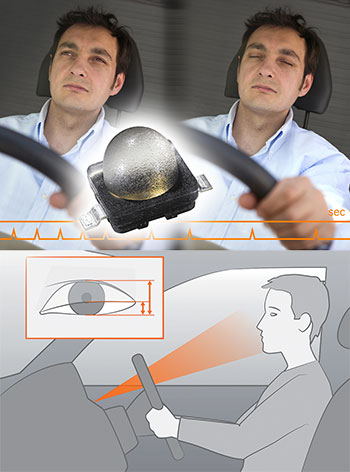From electronic systems that prevent accidents by automatic emergency braking to systems that actively monitor the overtired driver to adaptive front lighting, LED-based infrared light sources are being deployed inside and outside the vehicle to increase safety.
Research shows many traffic accidents could have been prevented with the latest technology. Electronic systems can react more quickly than drivers and prevent accidents by automatic emergency braking. If a crash is unavoidable, they significantly help minimize the consequences.

The reliable detection of traffic in front of the car is crucial to these systems. LED-based optical components play a key role in this application.
Traffic situations are too complex to be registered by a single sensor, and reliability is indispensable for automatic emergency braking or for pre-crash preparation when a collision is unavoidable.
Braking incorrectly can cause serious rear-end collisions. What is more, unintentionally triggering pyrotechnical belt tensioners and airbags generates high costs. Automotive manufacturers therefore rely on information from several kinds of sensors, including radar, its light-based sister-technology LIDAR (light detection and ranging) and, above all, cameras.
While LIDAR and radar are effective for detecting obstacles and measuring the distance and speed of other traffic participants, the camera provides other essential information: It can determine, for example, whether an obstacle is a large piece of paper flying around or a bicycle. Evaluation of the camera image also helps detect pedestrians and generally is suited to “seeing” everything going on around a vehicle.
More Light for Camera
The light sensitivity of modern digital cameras has increased significantly in recent years, but their performance in low light at night still is limited. The headlights help somewhat, but their light distribution and the elements that prevent the blinding of oncoming drivers restrict how well they can illuminate the road for the camera.
Therefore, another technology comes into play here: additional illumination with invisible infrared light. Lamps with infrared emitters based on LED technology will not blind anyone. Conventional CMOS (complementary metal-oxide-semiconductor) cameras can detect this near infrared light well and therefore capture a scene even at night with good contrast and range.
Radar provides precise data on cars up ahead at a fairly great distance. In city traffic or stop-and-go situations, however, the information it provides becomes inaccurate. This problem can be solved by a LIDAR system, which and functions like radar (radio detection and ranging) except that it uses laser light.
A LIDAR system measures the distance from objects and their speed by time-of-flight measurement of the laser pulses. To obtain more detailed information on the surroundings, a camera with a strong infrared light source (headlight) can be used to detect and classify objects in the vicinity of the vehicle without blinding oncoming traffic.
If an analysis of the collected data clearly indicates a dangerous situation, the system first gives the driver a warning, which can be a loud tone or an optical warning visualized in the front windshield. However, the warning presupposes the person behind the wheel still has time to intervene. If this no longer is possible because of reaction times, automatic emergency braking can follow.
Sometimes, even the best monitoring systems and the strongest brakes cannot prevent an accident from happening. In such cases however, these systems do help minimize the severity. The lower the impact speed, the less serious the damage and the lower the risk to passengers. For their protection, the safety belts can be pre-tensioned prior to impact and the seats moved into optimum position. Another option is to adapt the control of airbag release to the situation.
But it is not only the passengers inside a car who have a safety advantage from the thorough observation of what is going on in front of the car. The first cars with pedestrian airbags are now appearing on the market. They must only trigger when the system determines a person will hit the hood – and then only with absolute certainty.
Active Monitoring for Overtired Drivers
Distraction and fatigue are responsible for a lot of traffic accidents, particularly the more serious ones. Driver distraction is a major concern among traffic-safety experts. Passive car safety has increased considerably thanks to driver assistance systems, airbags and other technology and has resulted in significantly fewer injuries. However, distracted drivers are responsible for a rising number of accidents. According to insurance statistics, distraction is the cause of some 10% of accidents. Fatigue has an even greater impact on accidents: According to estimates of the Berlin-based German Insurance Assn., the umbrella organization for private insurers in Germany, overtired drivers are responsible for one in four highway accidents.
In its effort to reduce the number of accidents and fatalities, the automotive industry is turning increasingly to systems that warn drivers, in time, of dangerous actions and lack of concentration. Infrared light sources for interior camera systems and sensors already integrated into the vehicle play a central role in this new development.

Several years ago, the first systems emerged that warned drivers of fatigue or directed their attention to what is most important in a car: driving. These solutions draw their information from sensors already integrated into the vehicle for other purposes. One example is the steering-wheel-angle sensor, which primarily supplies the electronic stability program with data. This system also can detect the frequent occurrence of slight or inappropriate steering motions which indicate lack of concentration or fatigue.
For example, in the case of the notorious “microsleep,” an overtired driver holds the steering wheel almost totally motionless. As soon as he wakes up again, he gives a slight start. Analyzing signal and pedal activation, the latter via the pedal sensor, also can provide information on driver fatigue. The outwardly directed camera behind the rearview mirror mainly serves other driver assistance systems, such as the lane-departure-warning system. But the information that the car has nearly left the lane several times unintentionally over the last few minutes likewise can be used to warn a driver that his driving ability may be impaired.
Systems that actively monitor the driver are poised for full-scale production. For this application, a camera and an infrared light source are installed in the combination instrument near the tachometer. In this scenario, the camera focuses continuously on the face of the person behind the wheel.
In order to ensure the camera is operational in all light conditions, 940-nm infrared LED light sources are used so the system can operate in the dark or in different daylight situations. The driver is discretely illuminated with infrared light so he cannot see it, so he is not distracted by the light. A software program analyzes the camera image specifically in terms of the driver’s eyes.
For example, the blinking of the eyes, above all the frequency of blinking, provides information on how fatigued a driver is. Furthermore, if a driver looks to the side frequently and for a long period of time on a straight road, this can be an indication of lack of concentration on what is happening in front of the car. One challenge in this connection is analyzing the camera images: If a driver wears glasses or, even worse, sunglasses, more advanced software and higher-powered cameras are required to monitor the eyes.
In the above cases of fatigue and distraction, the system can trigger a warning to the driver. The auto manufacturer determines what kind of warning signal is given: Subtle to penetrating warning tones are just one possibility. A vibrating steering wheel is another way to warn a driver of his lack of concentration. Light strips with LED light sources on the lower edge of the vehicle windows also would be conceivable for directing the driver’s attention to the front, to what is happening on the road ahead of him.
Adaptive Front Lighting for Greater Safety
We have long since moved beyond using only the standard high and low beam functions in a vehicle to illuminate the road. In an increasing number of vehicles, adaptive front lighting systems provide exactly the right light for a given driving situation. In its latest form – glare-free high beams – the driver has the best possible visual range at night, at all times, without dazzling other drivers on the road.
In terms of its light-distribution pattern, the low-beam light considered standard today originated in the late 1950s, when asymmetric low-beam light was introduced in Europe. Since then, the right-hand side of the roadway has been illuminated significantly more than the left, the side of oncoming traffic. Compared to symmetric low beams, this change enhanced safety tremendously.
However, in the meantime, the traffic situation and motor vehicles have advanced dramatically. Speeds are higher and traffic density has increased significantly. As a result, the use of classical high beams during long-distance trips has dropped to about 2% of total driving time. Although the range of the low beams has more than doubled since the introduction of asymmetric light, the low-beam light and its distribution in no way have kept up with speeds now common, for example, on highways. Furthermore, asymmetric light does not offer any advantages in cities, where a wide, symmetric beam pattern is best.
The introduction of projection systems or lens headlamps made it possible to better control light distribution patterns to a great extent. After the turn of the millennium and approval by the authorities, the market introduced the first vehicles that were able to adapt their light to the driving speed. At standard city speeds, a wide “carpet” of light offers considerably better visibility of what is going on beside the road. Pedestrians are easier to see and, when turning a corner, more light than before falls in the new direction of travel. At inner-city speeds, the light does not need to have as long a range compared to what is needed for highway driving.
The situation is different on country roads. In many countries, drivers are obliged by law to drive at a speed that allows them to stop within the visibly clear distance ahead. If this principle is strictly applied, then a car using low-beam lights with today’s standard range never should travel any faster than 50 mph (80 km/h), even with the best headlamps.
But reality often is different in traffic today. Most severe accidents and traffic fatalities occur on country roads, and the numbers that occur at night are disproportionately high. Better light is a critical countermeasure, but first-generation adaptive front-lighting systems are not enough, because they have only standard low beams for country driving. Only the latest solutions with glare-free high-beam light offer greater visibility.
The situation is different yet again under highway conditions. While adapting speed to the visibly clear distance ahead no longer is required by law under certain circumstances in some countries, the visual range of conventional low beams no longer is commensurate with high speeds.
Headlamps with adaptive front-lighting systems raise the light slightly at highway speeds. The range of the headlamps increases accordingly, for another critical gain in safety. No one is dazzled by the light, because the distance to the car ahead likewise is greater in these traffic situations. Thanks to more widely spaced lanes, oncoming drivers do not suffer from the greater range of the highway beam pattern.
Sensors Make Light More Variable
With LED technology, control of the light-distribution pattern is almost infinitely variable, meaning it can be adapted to the driving situation, particularly on country roads. Adaptation depends not only on speed, but also on distance to the car ahead, the course of the road and any oncoming traffic.
If the system detects a highway or a highway-like road, it can select the right beam pattern even at low speed. For distance measurements, rapid-pulse laser diodes for LIDAR systems are available. To obtain more detailed information on the surroundings, a camera with a strong infrared light source (headlight) can be used to detect and classify objects in the vicinity of the vehicle without obstructing the vision of oncoming traffic.
At present, the absolute latest in adaptive front lighting development is glare-free high-beam light. With this technology, oncoming cars, vehicles ahead and – with the latest systems – even pedestrians are selectively shaded, or protected from glare. At the same time, drivers can exploit the advantages afforded by the long range of high-beam light: They can see farther, and that is a significant safety gain for all road users.
For example, the high-beam light reaches even beyond the vehicle ahead, enabling the driver to see pedestrians, cyclists and obstacles on the right-hand side of the road sooner. Cornering lights also fall into the category of using alternative light-distribution patterns. Under current regulations, headlamps are permitted to track the turn of the steering wheel up to 15 degrees.
These options already exist with classic light sources, such as xenon lamps. However, new LED light sources for headlamps offer a number of more extensive possibilities.
LED automotive headlamps always contain several LEDs. High-performance systems can have as many as 30 LEDs, each of which can be switched on and off separately. Together with the optical system that comes with every LED, alternative light-distribution patterns can be generated entirely without mechanical elements. One example is the matrix headlamp, such as that installed in the Audi A8.
With these headlamps, the high-beam light initially can be masked in two zones, meaning, for instance, separately for a vehicle in front and oncoming traffic or a pedestrian. This greatly enhances safety because the rest of the road, and thus also obstacles on it, are still fully illuminated.
In some situations, the driver ahead even has an advantage in that the glare-free high-beam light shines along the side of his vehicle, illuminating the road beyond. Furthermore, with matrix technology, the area directly in front of a vehicle can be illuminated brightly by additional LED light sources, with no deterioration in the light falling at a distance. Many drivers prefer good lighting directly in front of the car – although it is technically not necessary – because it is considered a pleasant effect. It promotes relaxed driving and therefore also enhances safety.
LEDs immediately deliver full luminous flux when switched on and they do not require numerous start-up cycles. No other automotive light source offers these advantages. Matrix light and its highly adaptive light-distribution patterns are possible only with LED technology. And developments still have a long way to go.
It already is possible today, for example, to briefly illuminate a pedestrian so there is no doubt the driver sees him. More extensive marking functions are conceivable in the future, such as signs along a planned route or the correct exit lane. The new technology also offers special advantages for responding to a frequent demand from many drivers for “bad-weather lighting.”
Until now, only the fog lights were available for this purpose, but their decades-old beam pattern is incapable of adequately handling the diverse visibility problems caused by the weather. Now, lighting engineers can develop optimum settings for rain, snow or fog.
Walter Rothmund is senior marketing manager-IR Components for Osram Opto Semiconductors.





